Oklahoma tornado choice: Trust school building integrity or retrieve kids?
Loading...
| Moore, Okla.
With an ominous storm approaching, the Moore Public School District flashed a text alert to parents: "We are currently holding all students until the current storm danger is over. Students are being released to parents only at this time."
Parents had a gut-wrenching choice, and only a few minutes to make it. Trust the safety of the seemingly solid school buildings and the protection of trained teachers and staff. Or drive frantically ahead of a massive tornado and attempt to take their children safely home.
"Something clicked in my head and said that my children would be afraid and they would be safer with me," said Amy Sharp, who jumped in her pickup, peeled off through pounding rain and hail, and pulled her 10- and 12-year-old daughters out Plaza Towers Elementary School.
Sharp survived with her children. But seven of the many remaining students died when the twister ripped down the school's roof and walls.
Exactly how do desperate parents like those in the path of the powerful Oklahoma tornado know when it's best to leave their children in a presumably safe place or race into the face of danger?
"You have that parent-child draw. That protective factor, where they want to go at any cost, no matter what. The options aren't very good in a tornado if you're thinking about going to rescue your children," said Ronald Stephens, executive director of the National School Safety Center that provides training to schools around the country.
"Which way is the wind going to twist? What's it going to pick up? What won't it pick up? Until someone becomes all-powerful, all-knowing and all-perceiving, it is tough to expect 100 percent perfection from schools and parents," he said.
The Oklahoma tornado provides a good example of the unpredictable death toll that disasters can inflict. Before it flattened Plaza Towers Elementary, the tornado also tore through Briarwood Elementary and — though the roof collapsed — everyone at Briarwood appears to have survived. Both schools lacked tornado safe rooms, and at both, students initially were sent to the halls before some teachers squeezed them into seemingly safer places such as closets and bathrooms.
David Wheeler would have liked to race to have rescued his 8-year-old son, Gabriel, before the tornado reached Briarwood. But Wheeler had to remain at a separate school where he worked. So he waited until the tornado cleared, then sped down the highway as far as he could and fibbed about being a first-responder so he could hitch a ride with a sheriff's deputy headed into the disaster zone. Once he got there, he slogged through broken glass and raw sewage to try to get to the school.
Wheeler ended up more injured than his son, who climbed from the rubble with scrapes and bruises after being sheltered by a teacher. Wheeler, meanwhile, had a large red rash on his legs — he thinks from the sewage — and multiple cuts and scrapes that required him to get a tetanus shot Tuesday.
"It was just kind of a surreal moment. I didn't know if my son was alive — it was the worst moment of my life," Wheeler said.
Stephens, a former school administrator who lives in Westlake Village, Calif., said the biggest challenge for parents who are racing the clock in a disaster is holding emotions in check.
"You're not going to be any good to your child if you take such great risk that you lose your life in the pursuit of attempting to save them when there are others who are onsite who hopefully will also use good judgment," Stephens said.
Simply showing up isn't enough.
"You want to have an entrance plan but also a completion plan. Can you make it out? Can you make it to safety?" he asked rhetorically.
Officials at the Moore School District choose not to dismiss students early. But that, too, is a tough call.
Troy Albert, a principal at Henryville Junior-Senior High in southeastern Indiana, let students out for the day on March 2, 2012, just moments before tornado sirens went off. No injuries were reported among the few staff, students and parents who remained at the school when a tornado packing 175 mph winds destroyed the building. School officials halted people from leaving only when they figured the tornado was within 10 minutes of hitting, fearing that wouldn't allow enough time for people to make it to safety.
"We trusted our protocols and it worked," Albert said. "I was questioned about whether we should dismiss school or whether we should bunker down here. Our decision to do that was based on the fact of the size of the tornado and what was coming. And we figured if you got them a mile away from our school you had a chance for survival."
With about 30-45 minutes of lead time on a potential tornado last year, Julie Hubbard jumped in her car and signed her son out of a Tennessee middle school ahead of the storm.
"There were just dozens of parents who went to pick up their kids that day. I don't know if they just tended to freak out more or what," said Hubbard, who now lives in Fort Gibson, Okla. "Growing up in Oklahoma, we have so many tornadoes. I just wanted to be home with my children."
A couple of hours before deciding to pick up her children before the tornado barreled through Moore on Monday, Sharp said she called the school office at Plaza Towers Elementary and asked if it was safe for them there. She said the receptionist replied: "They're pretty safe here."







